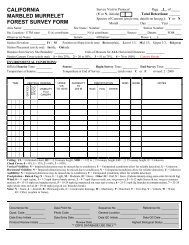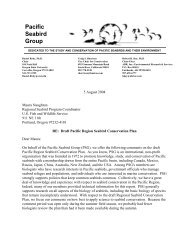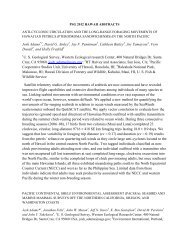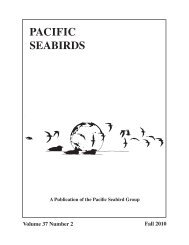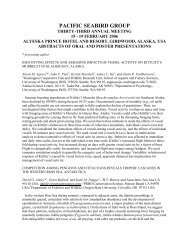abstracts of oral and poster presentations - Pacific Seabird Group
abstracts of oral and poster presentations - Pacific Seabird Group
abstracts of oral and poster presentations - Pacific Seabird Group
You also want an ePaper? Increase the reach of your titles
YUMPU automatically turns print PDFs into web optimized ePapers that Google loves.
varies greatly with distance from shore; therefore, the optimal survey design would orient transects<br />
perpendicular to shore <strong>and</strong> calculate density from line transects using radial distance estimates <strong>and</strong> measured<br />
angles.<br />
LINKING BREEDING AND WINTERING DIETS OF SYMPATRIC COMMON AND ARCTIC TERNS<br />
USING STABLE-NITROGEN AND STABLE-CARBON ISOTOPES<br />
Mathieu R. Charette* (mathieu.charette@unb.ca) <strong>and</strong> Antony W. Diamond; Atlantic Cooperative Wildlife<br />
Ecology Research Network <strong>and</strong> Dept. <strong>of</strong> Biology, University <strong>of</strong> New Brunswick, Fredericton, NB CANADA<br />
Our underst<strong>and</strong>ing <strong>of</strong> the biology <strong>and</strong> population dynamics in long distance migrant seabirds is<br />
restricted by our lack <strong>of</strong> underst<strong>and</strong>ing about their biology <strong>of</strong>f the breeding grounds. Common Terns (Sterna<br />
hirundo) <strong>and</strong> Arctic Terns (Sterna paradisaea) are closely-related seabirds with similar life-histories <strong>and</strong><br />
overlapping breeding ranges, but different migration routes <strong>and</strong> wintering grounds. We wanted to determine<br />
how terns alter their diets between the breeding <strong>and</strong> wintering grounds. Stable isotopes <strong>of</strong> Carbon [ 13 C/ 12 C] <strong>and</strong><br />
Nitrogen [ 15 N/ 14 N] allowed us to compare diet on the wintering grounds inferred from breast feathers, grown in<br />
winter, with albumen <strong>and</strong> yolk from eggs produced on the breeding grounds. We found a significant difference<br />
between Common <strong>and</strong> Arctic Tern diets on the wintering grounds; we also found no difference between the<br />
same species from two breeding colonies. Arctic Tern values indicate that they are feeding on Antarctic krill.<br />
Common Tern values suggest that they are feeding on marine fish. Both tern species changed their diets during<br />
egg production on the breeding grounds. On the breeding grounds, we found no difference between Common<br />
<strong>and</strong> Arctic Tern diets; feeding on a mix <strong>of</strong> shrimp <strong>and</strong> marine fish. There was a difference in both species diets<br />
between isl<strong>and</strong>s. We provide further evidence that Common <strong>and</strong> Arctic Terns use exogenous reserves for egg<br />
production.<br />
A NOTE OF CAUTION WHEN USING ANIMAL TISSUE PRESERVED IN QUEEN’S LYSIS BUFFER<br />
FOR CARBON AND NITROGEN STABLE-ISOTOPE ANALYSIS [Poster]<br />
Mathieu R. Charette* (mathieu.charette@unb.ca), Timothy D. Jardine, <strong>and</strong> Antony W. Diamond; Dept. <strong>of</strong><br />
Biology, University <strong>of</strong> New Brunswick, Fredericton, NB CANADA<br />
We analyzed the blood <strong>of</strong> 2 species <strong>of</strong> terns at different concentrations <strong>of</strong> blood to the preservative<br />
Queen’s lysis buffer (QLB) for stable-nitrogen (δ 15 N) <strong>and</strong> -carbon (δ 13 C) isotope analysis. We compared these<br />
values to QLB <strong>and</strong> 2002 untreated tern blood isotope values, to determine the effects <strong>of</strong> different concentrations<br />
on stable-isotope values <strong>of</strong> blood. The δ 15 N <strong>and</strong> δ 13 C values for the blood/QLB mix compared to % N values<br />
(range 2.48–9.50) revealed an effect <strong>of</strong> concentration on the δ 15 N values. QLB exhibits low stable-nitrogen<br />
values (δ 15 N = 0–0.46‰) <strong>and</strong> nitrogen content, which reduce the blood isotope values <strong>and</strong> % N <strong>of</strong> samples.<br />
This study demonstrates that blood/preservative concentrations, as well as different preservations methods, can<br />
affect stable-isotope ratios <strong>of</strong> carbon <strong>and</strong> nitrogen. The correction factor <strong>of</strong>fered by Hobson et al. (1997) for<br />
QLB can be used, but researchers must use the same concentration <strong>of</strong> blood to QLB. Concentration curves for<br />
the specific tissue can be constructed if concentrations are known. For studies using archived samples, we<br />
suggest more research emphasis on effects <strong>of</strong> preservatives, particularly for those samples containing different<br />
concentrations <strong>of</strong> tissue <strong>and</strong> preservative.<br />
ESTIMATING BYCATCH OF MARBLED MURRELETS IN CANADIAN GILLNET FISHERIES<br />
Kristin Charleton 1 (Kristinc@isl<strong>and</strong>.net), Douglas Bertram 1 , Ken Morgan 1 , Carol Eros 2 , <strong>and</strong> Bert Ionson 2 ;<br />
1 Canadian Wildlife Service, Institute <strong>of</strong> Ocean Sciences, Sidney, BC CANADA; 2 Dept. <strong>of</strong> Fisheries <strong>and</strong> Oceans,<br />
Vancouver, BC CANADA<br />
Marbled Murrelets are listed as Threatened in Canada, due primarily to nesting-habitat loss; however,<br />
threats from oil spills <strong>and</strong> gillnet mortality are acknowledged by the Committee on the Status <strong>of</strong> Endangered<br />
Wildlife in Canada (COSEWIC) as threats. Marbled Murrelet mortality due to commercial gillnet fishing in<br />
British Columbia has received little critical examination. A study conducted in Barkley Sound during 1979 <strong>and</strong><br />
1980 documented 28 Marbled Murrelet deaths that resulted from gillnet fisheries. Since that time, the<br />
Department <strong>of</strong> Fisheries <strong>and</strong> Oceans (DFO) has reduced the frequency <strong>and</strong> duration <strong>of</strong> commercial salmon



